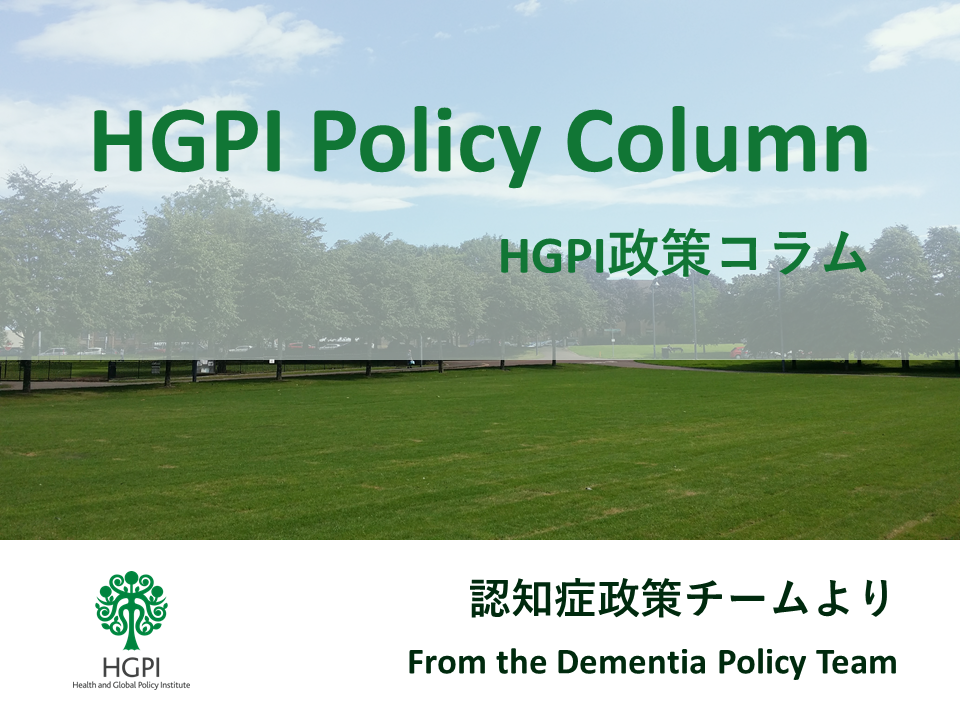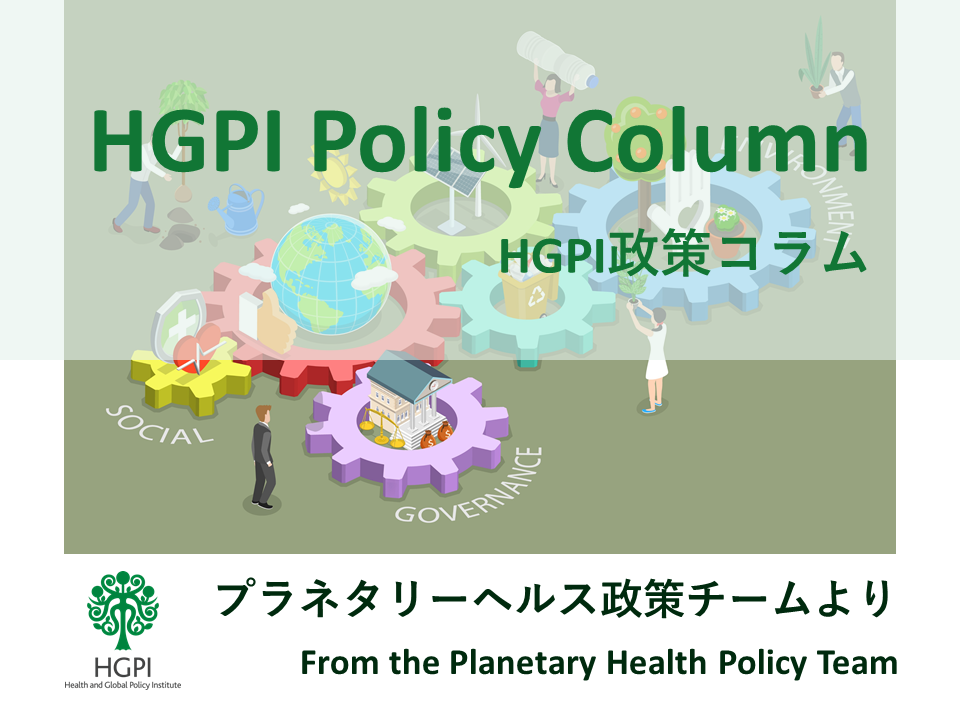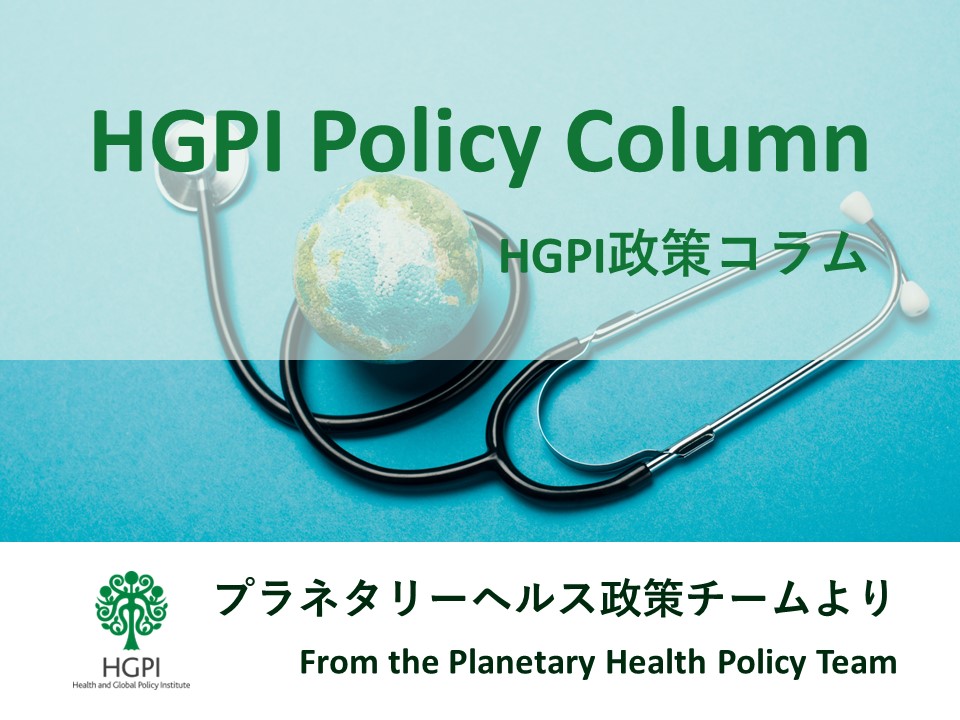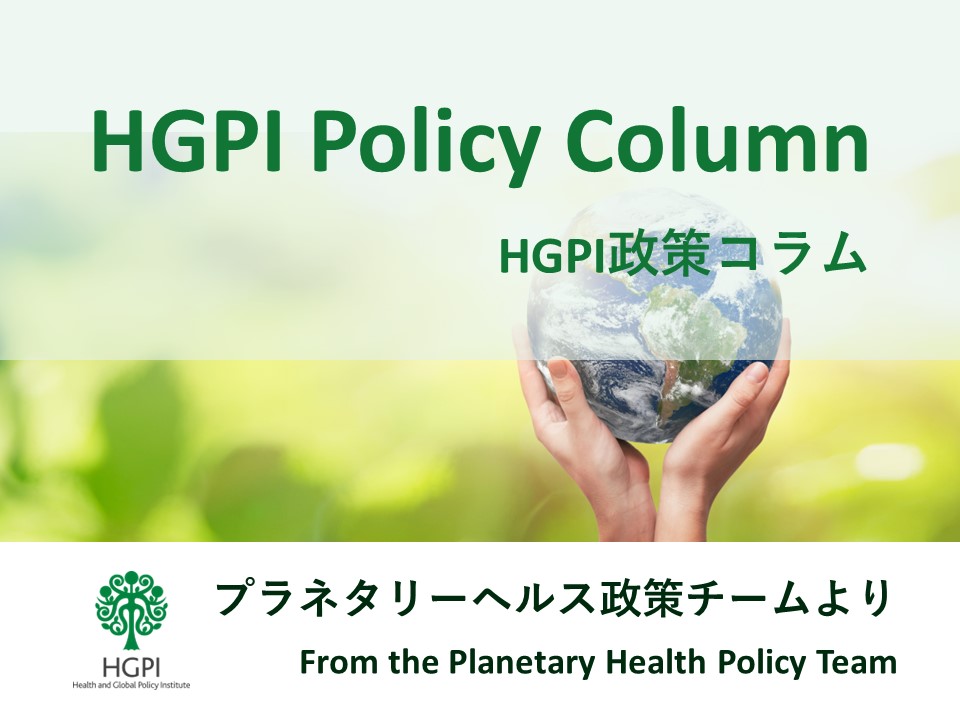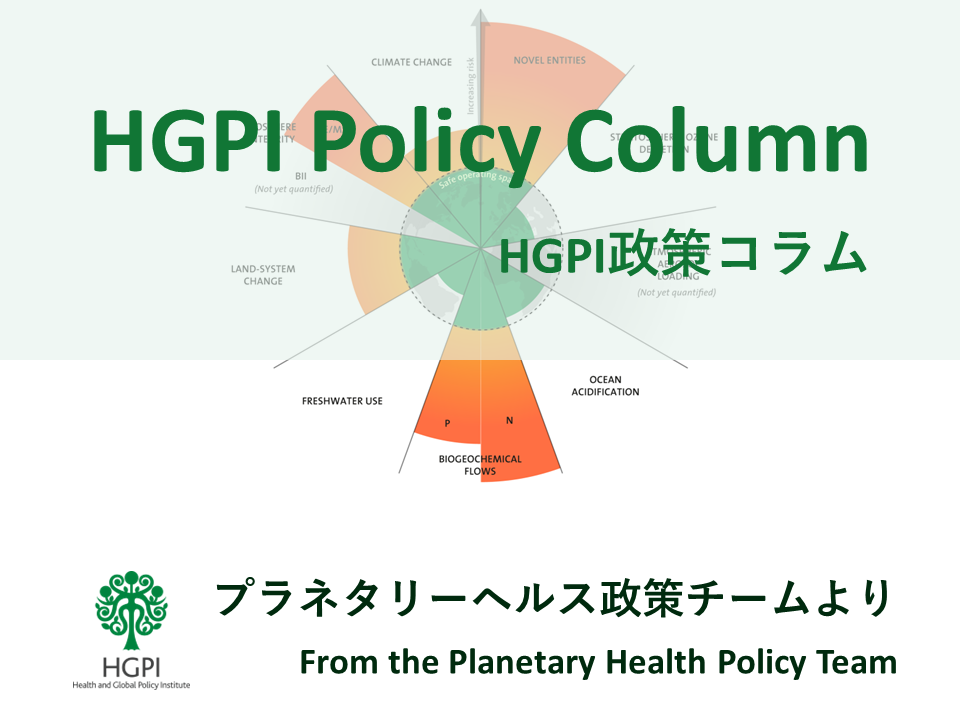[HGPI Policy Column] No. 35 – From the Planetary Health Policy Team, Part 5 – Initiatives for Planetary Health from Local Governments
date : 4/20/2023
![[HGPI Policy Column] No. 35 – From the Planetary Health Policy Team, Part 5 – Initiatives for Planetary Health from Local Governments](https://hgpi.org/en/wp-content/uploads/sites/2/column-35-top.png)
Key points of this column
- Historically, local governments have played key roles in the implementation of concrete policies for public health.
- Actions from local governments for pollution control taken during Japan’s period of rapid economic development served as starting points for measures for the environment.
- Many of Japan’s local governments are formulating action plans to be carbon neutral by 2050. Expectations are high for those plans to be carried out and evaluated appropriately and for them to be provided with the support they need.
Introduction
In 2023, the Government of Japan will take over the G7 Presidency from Germany. The G7 Hiroshima Summit will be held from May 19 through 21; the G7 Health Ministers’ Meeting will take place in Nagasaki on May 13 and 14; and the G7 Ministers’ Meeting on Climate, Energy and Environment will take place in Sapporo on April 15 and 16. Climate change is a global issue and its impact on human health is clear. Discussions on climate change have advanced over past G7 meetings led by the U.K. and Germany, and anticipation is high for continued global collaboration on this issue. The roles of local governments have also been attracting growing attention each year. The inaugural summit of the Partnership for Healthy Cities (PHC), a global network that Tokyo joined in 2019, was held on March 15, 2023 in London.1 In that partnership, five cities have been recognized for their efforts: Montevideo, Uruguay, which established food and nutritional standards; Mexico City, Mexico, for improving road safety; Vancouver, Canada, which promoted public health data; Athens, Greece, which reinforced measures for drug overdose prevention; and Bengaluru, India, which advanced efforts on tobacco control. Local governments are deeply involved in implementing measures for public health, with past examples including those for pollution control and environmental protection taken during Japan’s years of rapid economic expansion. Anticipation is high for the dissemination of good examples such as these. To address this need, this fifth column in our series on planetary health will introduce the roles of local governments and their measures for pollution and related issues.
- The role of local government in planetary health
Historically, local governments have played key roles in public health. From managing water quality to regulating tobacco, they have been leaders in various movements for better health and daily living for their community members.
To address the challenges of planetary health and protect human health on a global scale, it goes without saying that implementing regulations through laws and providing funding for these goals will be vital at both a global level that surpasses national boundaries and at a domestic level within the borders of each country. Measures that go beyond international borders will be essential for addressing issues like climate change, ozone depletion, and pollution from persistent organic substances, but actions at the global or national level are often time-consuming and come with practical challenges. Relatively speaking, local governments have a history of taking action to address public health challenges more rapidly.
Around 55% of the global population currently lives in cities, and by 2050, this percentage is projected to grow to 66%, or two-thirds of the population. Cities are the source of approximately 80% of global GDP, account for over 75% of natural resource consumption and 60% to 80% of energy consumption, and produce 75% of carbon emissions. It is no exaggeration to say that successfully achieving planetary health will depend on initiatives made at the level of municipal and local governments around the world.2
- Pollution measures from local governments in Japan
Initiatives from Japan’s local governments to address pollution, which has had significant impacts on both the environment and on human health, can be thought of as precursors to initiatives for planetary health.
Japan experienced a period after World War II when productivity was emphasized as the key factor for economic growth. In the 1960s and 1970s, air, water, noise, and vibration pollution from sources like factories and traffic began to be viewed as social problems, especially in major urban areas. Around that time, massive public investments were made to build roads and ports to establish an industrial infrastructure, but sufficient attention was not paid to investments that enhance the daily living environment like parks, sewage systems, and waste disposal.
At the time, the concept of pollution was still hazy. The Government had not yet established a system for rapidly enacting pollution control measures, and administrative duties for handling pollution were split among the various ministries and agencies that were related to each sector. It has been said that this structure made it so that the only method of dealing with pollution was through initiatives from local governments.3
The first national law on air pollution was enacted in 1962 and was called the Smoke and Soot Regulation Act. In 1967, the Basic Law for Environmental Pollution Control was enacted to address various pollution-related issues. It led to the gradual establishment of nationwide pollution control measures.4 In the following sections, we will take a look at initiatives for environmental problems from local governments that were early to take action for pollution control.
Minamata City, Kumamoto Prefecture
Minamata City experienced Minamata disease, which is referred to as one of the “big four” diseases caused by environmental pollution that appeared during Japan’s rapid economic growth. Based on lessons learned from those experiences, Minamata City issued Japan’s first “”Construction of a Model City for the Environment” in1992. Then, in 1993, the city enacted the Minamata City Basic Environment Ordinance.5 Afterward, Minamata City continued to actively pursue a number of initiatives for environmental preservation. In addition to being an early adopter of more rigorous practices for garbage sorting and recycling, efforts from Minamata City included creating its own environmental ISO standards (which are international standards for management systems for better environmental performance)6 for use in places like homes and schools and establishing an original certification system called the “Environmental Meister System” to recognize craftspeople who have adopted practices that are safe, friendly to the environment, and health-conscious.7
In accordance with the Minamata City Basic Environment Ordinance, the first Minamata Environmental Basic Plan was formulated in 1996. It was followed by the second Basic Plan in 2008 and the third in 2020. It has been reported that during the formulation of the third Minamata Environmental Basic Plan citizens exchanged opinions at a workshop for envisioning Minamata City ten years in the future. The plan includes six targets for 2027 that include “ Efforts to address the Minamata disease problem and promotion of ‘Moyai Naoshi’” and “ Realization of a low-carbon society.”8
Kitakyushu City, Fukuoka Prefecture
During the years of rapid economic expansion, one of Japan’s four major industrial areas formed in Kitakyushu City, Fukuoka Prefecture. It was centered around the heavy and chemical industry and caused various pollution problems for the city, including smog and water pollution. In the 1960s, however, citizens (in particular, women’s associations) launched a movement against air pollution, which paved the way for progress in pollution control measures.9
After Kitakyushu City worked to overcome its pollution problem from the 1950s to the 1970s, it utilized those experiences to develop a plan for making its community stand out more that was centered around measures to address environmental issues. The City established the Kitakyushu International Training Association (KITA; now the Kitakyushu International Techno-Cooperative Association) in 1980 and began collaborating with various cities in Asia to develop solutions to environmental problems. In 1997, Kitakyushu City became the first city in the country to start an Eco-Town Project. In 2010, it opened the Asia Low Carbon Center (now the Asian Center for Carbon Neutrality) with the goal of serving as a base for “low carbon revolution in Asia” The city has been selected as FutureCity, an SDGs FutureCity, and a Decarbonization Leading Area, and it remains a leader in comprehensive efforts for the environment and economic development.10
Specific efforts from Kitakyushu City include: establishing an innovative low-carbon model district called the “200 Year District,” which aims to create a net zero carbon urban district; implementing the Carbon-Offset & Eco-Point system, which distributes eco-points earned through environment-friendly activities and provides operating funds through carbon offsets; and creating a highly efficient transportation system that promotes methods of transportation that will contribute to lower carbon emissions.
- Past developments in community development initiatives for the environment
Table 1:Municipalities engaged in addressing environmental issues
In the late 1990s, cities around the world began attracting attention for initiatives for environmental problems. Similar developments occurred in Japan through the establishment of laws for recycling and other measures. The “Eco-Towns” certification program was launched in 1997 and was the first program from the Government of Japan aimed at supporting cities engaged in efforts for the environment. In that system, the Government provided support to cities that advanced community development efforts under “ Zero Emission Concept,” which were concept to reduce all forms of waste to zero by fully utilizing waste materials from one industry as raw materials for another. From 1997 to 2006, 26 local governments were certified as Eco-Towns.
Eco-Towns were a precursor to Eco-Model Cities, which was a program that started in 2008 in which the Government selected certain cities for their groundbreaking efforts for achieving a low-carbon society. At a time when knowledge regarding how to develop communities around that goal was limited, cities selected as Eco-Model Cities had to demonstrate they were fully utilizing local resources and could serve as models that could lead the way for other municipalities. After Prime Minister Fukuda gave a policy speech in 2008 mentioning, “achieving a low-carbon society,” a call for applications for Eco-Model Cities began and 13 municipalities were selected that year. Then, in an effort taken in response to the Great East Japan Earthquake in 2011 that aimed to expand low-carbon community development initiatives throughout the country, seven cities were selected in 2012 and three more were selected in 2013.
The FutureCities initiative is similar to that of Eco-Model Cities. In addition to decarbonization initiatives in Eco-Model Cities, the criteria for a city to be selected as an FutureCity include those meant to address issues unique to each region, such as those for responding to a super-aging society. In 2011, eleven regions were selected as FutureCities.
In 2018, the Government followed up on these initiatives by launching an initiative, which is based on the Sustainable Development Goals (SDGs) set by the United Nations, that designates certain cities as “SDGs FutureCities.” This designation is given to recognize local governments that have proposed noteworthy initiatives for regional development as described by the second Abe Cabinet in 2014. Such initiatives aim to revitalize areas in rapid decline due to factors like depopulation. By 2022, a total of 154 cities had been named SDGs FutureCities and, to recognize initiatives that are particularly noteworthy, a total of 50 were designated “Municipal SDGs Model Projects.” Compared to Eco-Model Cities, SDGs FutureCity designation covers a variety of regional development measures in addition to measures for decarbonization.11
Among SDGs FutureCities, innovative examples from the Kitakyushu City, Toyama City, and Shimokawa Town in Hokkaido were presented in Sustainable Development Goals (SDGs) / Voluntary Local Review (VLR) Reports, which were the first SDG reporting carried out by local governments anywhere in the world and was presented at the 2018 UN High Level Political Forum (HLPF 2018). It was created together with the Institute for Global Environmental Strategies (IGES) and was structured according to the United Nations Voluntary National Review (VNR) guidelines. The reports introduced examples of cities that implemented policy visions and plans that incorporated SDGs while taking their history and regional characteristics into account, and expectations are high for it to serve as a reference for municipalities in Japan and overseas.12
Toyama City, Toyama Prefecture
Toyama City has been designated both an Environmental Model City and SDGs FutureCity. It is currently in its third Toyama City Environmental Model City Action Plan, which covers 2019 to 2023.
Toyama City was included in the City Report, which mentioned that it has achieved sustainability through compact city planning based on polycentric transport networks. The Report also emphasized that Toyama City has helped promote the implementation of the SDGs on the international level by deepening collaborative efforts with cities in other countries. These efforts included sharing technological know-how across national borders and exporting project packages and policies.
Shimokawa Town, Kamikawa District, Hokkaido
Shimokawa Town is a town located in northern Hokkaido that is 90% forested and is well-known for its forestry industry and its woody biomass-based energy initiatives. Shimokawa Town’s population was approximately 3,200 people in 2021, but by 2030, its population is projected to decrease to 2,400 with 43% of its people being 65 years of age and older. The town launched efforts to achieve sustainability in the local community in the 2000s under the concept of “Developing a sustainable local community through harmony among the economy, society, and the environment.”
To set objectives that reflect current circumstances in Shimokawa Town, ten community members and around ten members of administrative staff held thirteen discussion sessions that started from the stage of introducing the SDGs.13 The SDGs Report notes that while maintaining a foundation of cyclical forest management, Shimokawa Town is working to create value across the dimensions of economy, society, and environment, and to build a sustainable community through comprehensive solutions.
-
- Many cities have implemented measures to address environmental challenges that the national Government has recognized and supported as official projects. In addition to avoiding the negative impact of environmental problems, many of those measures also have the potential to have positive effects on human health. Behaviors with the potential to benefit both the environment and human health are called “co-benefit actions.” In recent years, co-benefit actions have been a key element when considering planetary health. Examples of co-benefit actions like those described in Table 2 were also discussed in the 2021 paper, and it is safe to say that many local governments in Japan have already started initiatives in line with these actions.14
Table 2: Examples of co-benefit actions and how they benefit both human health and the environment 14
|
Food choices |
Adopting a plant-based diet that is rich in fruits, vegetables, nuts, and legumes enhances sustainability and can reduce the carbon footprint of agriculture. |
|
Active transport |
Utilizing forms of transportation that involve physical activity like cycling or walking reduces emissions and protects against multiple diseases. |
|
Reproductive health |
Expanding opportunities for people to decide whether or not to have children can improve maternal and child health while limiting population growth due to unintended pregnancies. |
|
Connecting with nature |
Finding ways to spend more time in nature—including green space in cities—can benefit both physical and mental health and foster a sense of stewardship for the natural environment. |
|
Community engagement |
Fostering social connections through community engagement benefits mental health while building the social capital needed for collective action (to address issues facing the environment). Such connections are effective for planetary health when pursuing shared goals like creating more bike lanes, composting services, and farmers’ markets in communities. |
|
Sustainable drug prescribing |
Eco-directed Sustainable Drug Prescribing (EDSP) has been proposed to prevent the adverse effects that certain active pharmaceutical ingredients (APIs) can have on the environment. |
|
Preventive medicine |
As the number of older adults and the overall population increase, the carbon footprint of healthcare is not improving, and diagnostic and treatment methods are becoming more complex. In addition to benefiting patients, preventive medicine will be important for lowering the intensity of high–carbon healthcare. |
- Initiatives from local governments to achieve carbon neutrality by 2050
In our fourth column, we reported on Japan’s October 2020 declaration to achieve carbon neutrality by 2050. As of January 2023, 831 local governments representing 98.7% of the total population of Japan have endorsed this mission and have committed to becoming “2050 Zero Carbon Cities.”15
Starting in 2022, the Ministry of the Environment has also begun accepting applications for “Decarbonization Leading Areas.” These are areas that aim to achieve net zero CO2 emissions (including household and other civil sector emissions) by 2050 and a 46% reduction in emissions by 2030 (which is the national target and is based on FY2013 levels). One hundred municipalities are planned to be selected as “Decarbonization Leading Areas” by 2030 and they will receive financial support from the national Government. Twenty-six areas were selected in the first round and twenty were selected in the second round. Information regarding the current status of each local governing body’s efforts to achieve carbon neutrality by 2050 is available on the Ministry of the Environment’s Support Site for Action Plans of Local Governments Formulation and Implementation.16, 17
- Initiatives from local governments in Japan and overseas
Overseas, a number of initiatives for the environment from local governments are already underway. One recent example is the Climate Emergency Declaration, an initiative that many national and local governments around the world have been advancing together since around 2016. Climate Emergency Declarations are issued to express recognition of the severe impact of climate change and to advocate for the need to adopt urgent and effective measures to address it. The world’s first Climate Emergency Declaration was issued in 2016 by the Darebin Council in Melbourne, Australia. Japan’s first Climate Emergency Declaration was issued by Iki City, Nagasaki Prefecture in September 2019, and the Diet passed a resolution to do the same on November 20, 2020. By November 2022, it had been endorsed by 130 local governments in Japan.18
As of February 2023, Climate Emergency Declarations had been issued by 2,318 local governments in 40 countries around the world. Populations covered by these jurisdictions amount to over 1 billion citizens.19 While the Declarations themselves are non-binding resolutions and do not constitute institutional frameworks, expectations are high for them to enhance awareness toward climate change, to make climate action a higher priority, and to set directions for policy and citizen action.
Iki City, Nagasaki Prefecture
Iki City is a municipality of about 26,000 people located on an island northwest of Hakata Port in Fukuoka Prefecture. By high-speed boat, it can be accessed in about one hour. As one of Japan’s remote islands, it had already faced a number of challenges including social and economic concerns due to depopulation and a lack of human resources to carry on the community. From an environmental perspective, Iki City struggled with insufficient awareness toward conserving energy and a lack of progress in efforts to transition to renewable energy sources even though the island relies on thermal power generation. Iki City’s interests coincided with those of the SDGs, which take into account the three aspects of economy, society, and environment, and this led to its selection as an SDGs FutureCity.
Compared to five decades ago, fish catches in Iki City have fallen by half due to coastal desertification caused by rising seawater temperatures. In addition, the island has experienced a series of natural disasters like typhoons and torrential rains of a severity that was previously said to occur once every fifty years. These events brought the residents of Iki City together to develop a plan for global warming. The City’s 2018 plan titled the “Vision for Achieving a Low-Carbon, Hydrogen-based Society by 2030” set targets that included increasing its share of energy from renewables and hydrogen to 24% by 2030 and 100% by 2050. This was in line with the targets of the Climate Emergency Declaration, which led to Iki City becoming the first region in Japan to make one such declaration. It is said that issuing the declaration was beneficial to the administration and management in Iki City. For example, it received a number of consultations from organizations on the island who wanted to issue the Declaration and attracted new business proposals from the private sector.20
The One Planet City Challenge (OPCC)
One way to learn about initiatives for climate change from local governments in other countries is through the One Planet City Challenge (OPCC). The OPCC is a global competition hosted by the World Wide Fund for Nature (WWF) that examines actions to address climate change from cities.21 WWF has partnered with Local Governments for Sustainability (ICLEI) to hold this competition since 2011.
The OPCC jury focuses on items like roadmaps to lower greenhouse gas emissions that are highly transparent and scientifically sound or ambitious, as well as strategic action plans that are consistent with OPCC objectives (such as for the adoption of renewable energy). Past participants from Japan include the Tokyo Metropolis, Yokohama City, Kyoto Prefecture, and Toyama Prefecture. Past winners selected as outstanding global cities include Vancouver (2013), Cape Town (2014), Seoul (2015), Paris (2016), and Uppsala (2018), and there are high expectations for their efforts to serve as models for other cities to follow when taking action for the environment.
Yokohama City, Kanagawa Prefecture
Yokohama City is home to approximately 3.77 million people, making it Japan’s largest municipality. In addition to being selected as an FutureCity, an Eco-Model City, and an SDGs FutureCity, it was named a national winner of the WWF’s City Challenge 2018 (Tokyo received Special Mention). Yokohama City is also targeting net zero carbon emissions in accordance with the Zero Carbon Yokohama declaration. In 2021, it established the Municipal Council For Carbon Neutrality, which is chaired by Yokohama City and has approximately 160 member cities across Japan that have come together for concrete discussions on achieving a net zero carbon society.
By 2050, Yokohama City aims to reduce its energy consumption by approximately 50% and to generate 100% of its electricity using renewable energy sources, and it is calling upon citizens and businesses to work toward these targets. Yokohama City is taking active steps to change, as well. After committing to derive 100% of the electricity consumed by New Yokohama City Hall (which opened in April 2020) from renewable energy sources, it achieved that goal in March 2021. It has implemented a number of other initiatives, as well. These included running a campaign where citizens could purchase affordable solar power generating equipment and storage batteries for home use. It also installed solar panels and storage batteries on the roofs of the city’s 65 elementary and middle schools to provide electricity.
Conclusion
In this column, we focused on efforts for the environment from local governments in Japan. As mentioned in The Lancet, when taking action to address issues facing public health, it will be vital for there to be collaboration at the global and national levels. However, initiatives at the level of local government are essential when transforming our ideals and visions for the future into plans that reflect the realities we face, as well as when carrying out those plans. As we have seen, there have been several good examples from Japan in which local governments implemented measures that started from pollution control and, leveraging the unique characteristics of their communities, expanded those measures to address environmental issues and linked them to economic development. We introduced past examples of such initiatives in Table 1, and Table 2 showed examples of co-benefit actions in the context of planetary health. Some of those initiatives may already have been implemented in Japan, and we look forward to seeing more good examples from each region of the country in the future.
Local governments throughout Japan are now starting to take steps toward formulating and initiating plans to achieve carbon neutrality by 2050. We have high hopes of seeing those plans properly implemented and evaluated in the future.
Works referenced
- Tokyo Municipal Government. “Regarding Tokyo’s Participation in the Partnership for Healthy Cities.” December 13, 2019. https://www.metro.tokyo.lg.jp/tosei/hodohappyo/press/2019/12/13/01.html
- Hancock, T., Capon, , Dooris, M., & Patrick, R. (2017). One Planet Regions: Planetary Health at the Local Level. The Lancet Planetary Health, 1(3), E92–E93. https://www.thelancet.com/journals/lanplh/article/PIIS2542-5196(17)30044-X/fulltext
- Yokkaichi Pollution and Environmental Museum for Future Awareness. “Early measures from Mie Prefecture and Yokkaichi City.” https://www.city.yokkaichi.mie.jp/yokkaichikougai-kankyoumiraikan/about-yokkaichi-pollution/countermeasures/
- Yokkaichi Pollution and Environmental Museum for Future Awareness. “The Establishment of Legal Measures for Pollution.” https://www.city.yokkaichi.mie.jp/yokkaichikougai-kankyoumiraikan/about-yokkaichi-pollution/countermeasures/countermeasures09/
- The Kumamoto Prefecture Minamata City Environment Website. “Minamata City’s Objectives as an Eco-Model City.” May 31, 2019. https://www.city.minamata.lg.jp/kankyo/kiji00372/index.html
- The Kumamoto Prefecture Minamata City Environment Website. “Minamata City’s Environmental ISO Management System.” June 6, 2019. https://www.city.minamata.lg.jp/kankyo/kiji00378/index.html
- The Kumamoto Prefecture Minamata City Environment Website. “The Environment Meister Program.” May 13, 2021. https://www.city.minamata.lg.jp/kankyo/kiji003132/index.html
- The Kumamoto Prefecture Minamata City Environment Website. “The Third Minamata City Basic Plan on the Environment.” April 15, 2020. https://www.city.minamata.lg.jp/kankyo/kiji0031784/index.html
- City of Kitakyushu. ”Initiatives for Overcoming Pollution.” June 30, 2022. https://www.city.kitakyushu.lg.jp/kankyou/file_0269.html
- City of Kitakyushu. “The Asian Center for Carbon Neutrality.” February 8, 2023. https://www.city.kitakyushu.lg.jp/kankyou/file_0477.html
- Spaceship Earth. “Introducing Eco-Model Cities: How they differ from Environmental FutureCities, SDGs FutureCities, examples of initiatives, and list of cities.” November 16, 2022. https://spaceshipearth.jp/eco-friendly-model-city/
- The Institute for Global Environmental Strategies. “SDGs City Reports.” July 2018. https://www.iges.or.jp/en/projects/city-reports
- Sotokoto Online, Inc. SDGs Magazine for the Future. “Seven Goals Set by Hokkaido’s Shimokawa Town as an SDGs FutureCity.” July 19, 2021. https://sotokoto-online.jp/local/230
- Redvers, N. (2021). Patient-Planetary Health Co-Benefit Prescribing: Emerging Considerations for Health Policy and Health Professional Practice. Front Public Health, 9: 678545. https://www.ncbi.nlm.nih.gov/pmc/articles/PMC8119779/
- Ministry of the Environment, Government of Japan. “Status of Declarations to Become 2050 Zero Carbon Cities Among Local Governments.” February 2023. https://www.env.go.jp/policy/zerocarbon.html
- Ministry of the Environment, Government of Japan. “ 2050 Zero Carbon Cities in Japan” https://www.env.go.jp/en/earth/cc/2050_zero_carbon_cities_in_japan.html
- Ministry of the Environment, Government of Japan. “Support Site for Local Government Action Plan Creation and Implementation – Introducing Local Government Action Plans.” https://www.env.go.jp/policy/local_keikaku/
- Institute for Studies in Happiness, Economy and Society. “Climate Local Governments in Japan That Have Declared Climate Emergencies.” https://www.es-inc.jp/ced/index.html
- Climate emergency declarations in 2,320 jurisdictions and local governments cover 1 billion citizens. (2023, Mar 22) Climate Emergency Declaration. https://climateemergencydeclaration.org/climate-emergency-declarations-cover-15-million-citizens/
- The SMOUT Migration Laboratory. “The Power of Dialogue for Environmental Issues – Lessons From Iki City, Nagasaki Prefecture, Japan’s First Municipality to Declare a Climate Emergency.” January 20, 2020. https://lab.smout.jp/area_japan/nagasaki/iki-shi/interview-ikishi-2524
- World Wide Fund for Nature. “The One Planet City Challenge Participants Booklet Information for OPCC cities 2021-2022.” https://www.wwf.or.jp/activities/data/20210603climate01.pdf
Column authors:
Sayaka Honda (Program Specialist, HGPI)
Eri Cahill (Intern, HGPI)
Shu Suzuki (Associate, HGPI)
Joji Sugawara (Senior Manager, HGPI)
Top Research & Recommendations Posts
- [Research Report] Perceptions, Knowledge, Actions and Perspectives of Healthcare Organizations in Japan in Relation to Climate Change and Health: A Cross-Sectional Study (November 13, 2025)
- [Research Report] The 2025 Public Opinion Survey on Healthcare in Japan (March 17, 2025)
- [Policy Recommendations] Mental Health Project: Recommendations on Three Issues in the Area of Mental Health (July 4, 2025)
- [Research Report] The 2023 Public Opinion Survey on Satisfaction in Healthcare in Japan and Healthcare Applications of Generative AI (January 11, 2024)
- [Policy Recommendations] Developing a National Health and Climate Strategy for Japan (June 26, 2024)
- [Policy Recommendations] Reshaping Japan’s Immunization Policy for Life Course Coverage and Vaccine Equity: Challenges and Prospects for an Era of Prevention and Health Promotion (April 25, 2025)
- [Policy Recommendations] Recommendations on Strategic Investments in Policies for Brain Health to Revitalize Japan: Hopes for the New Administration (December 1, 2025)
- [Announcement] HGPI Endorses the “Belém Health Action Plan” (November 14, 2025)
- [Announcement] HGPI Joins Global Green and Healthy Hospitals (August 1, 2023)
- [Research Report] AMR Policy Update #2: WHO’s First Report on Fungal Infection—Bridging the Gap Between Clinical Practice and R&D
Featured Posts
-
2025-12-09
[Event Report] Special Seminar “Rising to New Challenges in Health Sciences for Future Society: Novel Developments in the Field of Epilepsy in Japan and Globally” Belgium Pavilion Special Seminar, World Expo 2025 Osaka, Kansai (September 18, 2025)
![[Event Report] Special Seminar “Rising to New Challenges in Health Sciences for Future Society: Novel Developments in the Field of Epilepsy in Japan and Globally” Belgium Pavilion Special Seminar, World Expo 2025 Osaka, Kansai (September 18, 2025)](https://hgpi.org/en/wp-content/uploads/sites/2/HGPI_20250805_mental-health-expo-eyechatch.png)
-
2025-12-11
[Event Report] Core Components of Universal Health Coverage (UHC): Achieving “Healthcare Without Financial Hardship” in Asia-Pacific and Japan (December 5, 2025)
![[Event Report] Core Components of Universal Health Coverage (UHC): Achieving “Healthcare Without Financial Hardship” in Asia-Pacific and Japan (December 5, 2025)](https://hgpi.org/en/wp-content/uploads/sites/2/HGPI_20251210_Core-Components-of-Universal-Health-CoverageUHC-top.jpg)
-
2025-12-12
[Registration Open] Meaningful Involvement Promotion Project Urgent Symposium “The New Takaichi Administration and Central Social Insurance Medical Council Reform – Ensuring Patients’ Voices are Heard” (January 22, 2026)
![[Registration Open] Meaningful Involvement Promotion Project Urgent Symposium “The New Takaichi Administration and Central Social Insurance Medical Council Reform – Ensuring Patients’ Voices are Heard” (January 22, 2026)](https://hgpi.org/en/wp-content/uploads/sites/2/HGPI_20251208_urgent-symposium-1.png)
-
2025-12-12
[Registration Open] (Webinar) The 140th HGPI Seminar “Early Detection to Reduce COPD Disease Burden: Connecting Clinical Frontiers with Health Policy” (January 27, 2026)
![[Registration Open] (Webinar) The 140th HGPI Seminar “Early Detection to Reduce COPD Disease Burden: Connecting Clinical Frontiers with Health Policy” (January 27, 2026)](https://hgpi.org/en/wp-content/uploads/sites/2/hs140-top.png)
-
2025-12-16
[Discussion Points] Policy Dialogue “Considering Comprehensive Genomic Profiling from the Perspective of Patient Access: Utilizing the Medical Service Fee Reimbursement System and the Mixed Medical Services Program to Meet the Needs of Today” (November 28, 2025)
![[Discussion Points] Policy Dialogue “Considering Comprehensive Genomic Profiling from the Perspective of Patient Access: Utilizing the Medical Service Fee Reimbursement System and the Mixed Medical Services Program to Meet the Needs of Today” (November 28, 2025)](https://hgpi.org/en/wp-content/uploads/sites/2/eyecatch_Policy-Dialogue_Discussion-Points_20251128.jpg)




